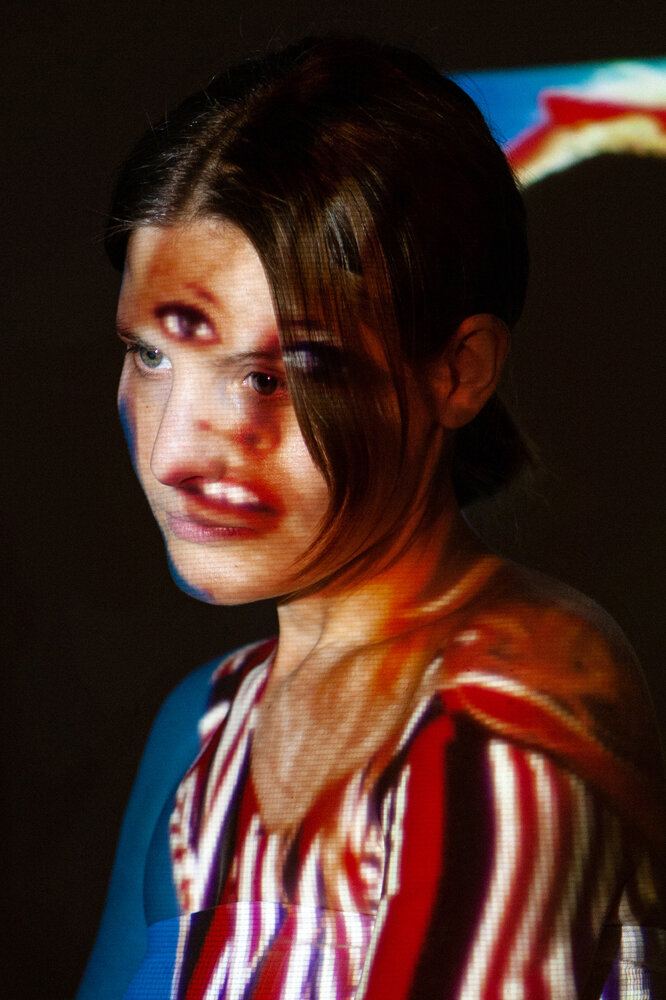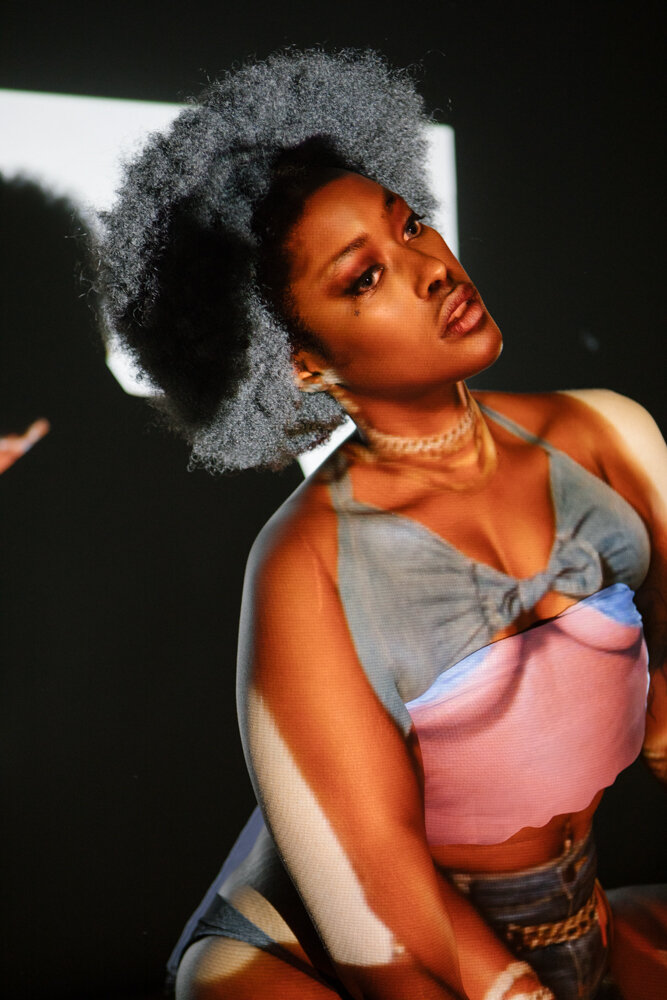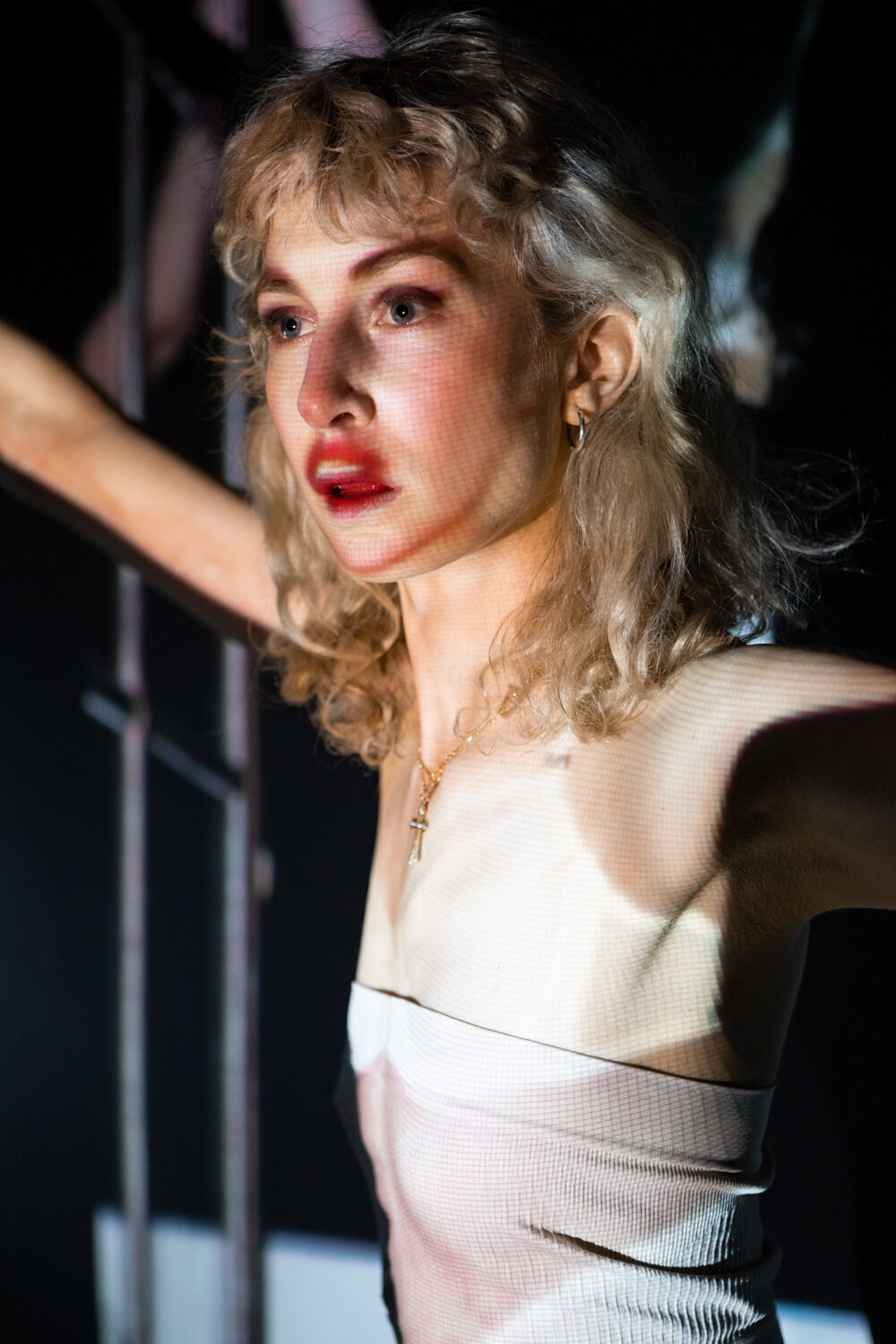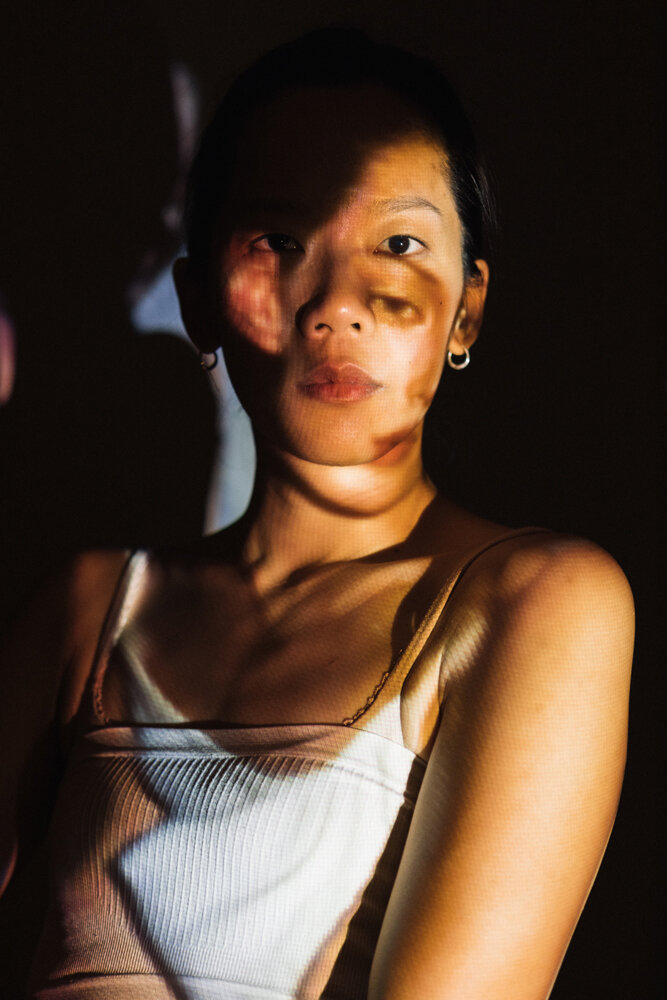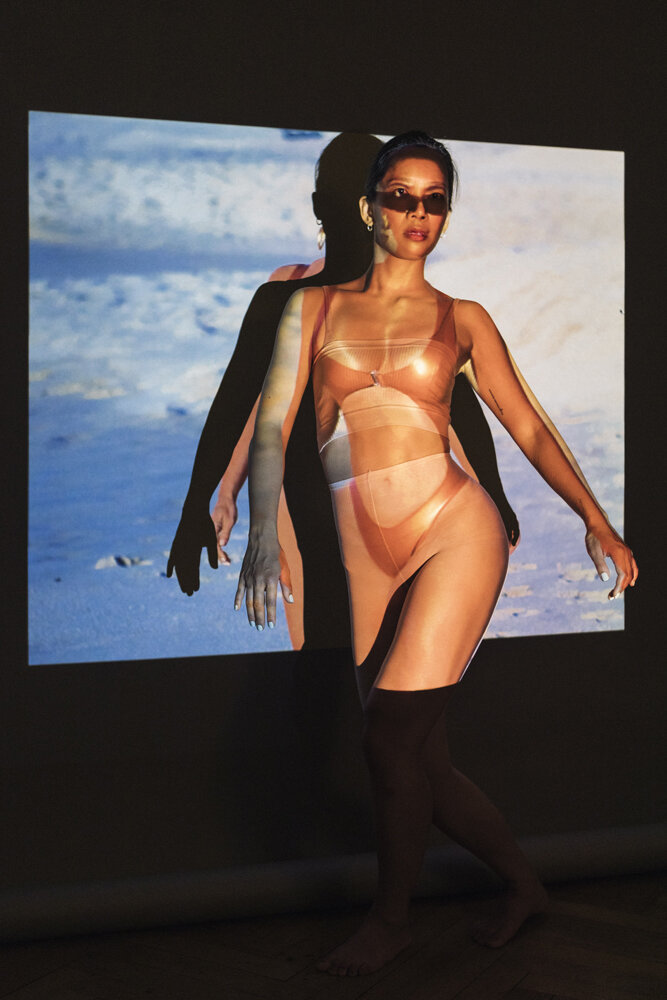Interview with Nora Heinisch
Nora Heinisch is a Berlin based photographer. She films people while they pose and become their own photographs. In her artistic works, at the interface between film and photography, Nora translates her observations into striking images with a clear message. We spoke to Nora about her current project Why Can’t I Hold All These Projections?, about Cindy Crawford, Kim Kardashian and the immense influence images have on self-perception, especially for women.
Linda (Why Can’t I Hold All These Projections), Selbstportrait ©noraheinisch
TEMA: Hello, dear Nora, can you briefly tell us what you are doing?
Nora: I went to Braunschweig when I was 18 and studied communication design there. For my Master's degree in Visual Communication, I went to the UdK in Berlin, where I also completed my Meisterschüler 2016. Already for my final work from 2016 (Vorbilder nachbilden), I filmed people striking poses in front of the camera. When we see a camera, we can't help but pose. As a photographer, I could often observe how people become an image in front of the camera. This process of becoming an image is something that happens constantly in our everyday life: as soon as we feel another person’s gaze, we start posing. We jump from one image to another. We speak with our bodies. In our everyday life we react to our environment, we are fluid and communicate with each other. This is something reciprocal. The camera takes that away and pulls us out, immobilises us. For many people, this causes them to falter in front of the camera. The confrontation with our own impression, the decision of how we want to be seen, is focused by the camera. That's exactly why I find photography so exciting - it's like a magnifying glass that can make things visible that we otherwise only perceive subconsciously.
TEMA: Your current project is called Why Can't I Hold All These Projections? For this work, you project almost iconic images of female celebrities (Cindy Crawford, Kim Kardashian or Audrey Hepburn) onto women and you film them trying to strike the poses of the celebrities. What images do you project onto the women?
Nora: I project images of beautiful, famous women. Images that reduce women or sexualise them; but also images like the mother, the housewife or the bride. I think women are far too complex and cannot be reduced to one image. When I ask women about their role models, they are actually more ideal role models. So women they appreciate for their work or for their charisma, but not for the beautiful images that exist of them. Ultimately, I am concerned with the combination of all these images that often distract women from their actual role models.
"My work to me is like an expedition.”
TEMA: So the images you use are basically not images that we necessarily consider as role models, but rather images that are projected onto us from outside? Who projects these images onto us?
Nora: I don't think there is anyone specific. We have fallen into a spiral from which it is difficult to break out again. My hypothesis is that a large part of our identity is made up of what we have seen, heard and felt so far. When we look at ourselves like a wall, we take bricks from everywhere – consciously or unconsciously – and put ourselves together. These bricks are mainly images, because seeing is the sense we rely on the most. I always say, "What happens in front of the camera - posing - is an extreme" and most of the time it's extremely neutral because as an image you can't react anymore. I think people have always been influenced by what they saw, but it was always elusive and not captured to that extent. More and more, we are trying to become photographs and movies. It looks like reality - but it's not. It is only a very small fraction. And it's impossible to become that and reduce yourself to an image.
TEMA: And this image is extremely manipulable.
Nora: And it's also understandable that we manipulate it. There is a lot of self-protection in it. If you no longer have control over what happens to your image, then of course you want to make sure that you are as invulnerable as possible. But if this image becomes a model for others in their everyday life, we have a problem and that's exactly what's happening in my eyes.
TEMA: Was the idea for the project Why Can't I Hold All These Projections born out of this concern?
Nora: I have concerned myself with the topic of identity a lot my whole life. Identity is a big, fascinating riddle for me. You asked me if I see myself as a curator or a director, but I would rather call myself an explorer. My work to me is like an expedition. There are so many questions in my head. My work helps me find answers and then pass them on to others.
TEMA: As an explorer, do you mainly examine the object, the person in front of the camera, or do you also deal with yourself in your role as a photographer?
Nora: People in front of the camera have to present themselves in a certain way in order not to be hurt. That is a form of protection and it takes a lot of courage to break through it . It is a risk. And not many have the privilege to take that risk. Perhaps, I see it as my responsibility, as the responsibility I would like to take. I want to raise awareness because I also believe that many more people could take this risk and the more who dare, the more things will change.
"You are more than beautiful."
TEMA: Let's get back to your current project: How do new filmings come about?
Nora: By now, I have a relatively large, daily growing pool of images that I can and want to project. Some of the participants also bring their own images and we decide together which images they want to "try on" in each case. In the end, the performers become projection surfaces and thus represent many women. Just to give you an example of how I choose images: Cindy Crawford - without Cindy Crawford I would no longer have this mole. I really wanted to get rid of it because I was bullied for it at school. My mum showed me pictures of Cindy Crawford and said, "You can be beautiful, even with a mole." For me, that was like a little reassurance pill at the time: Okay, there's this woman, she's beautiful even though she has a mole. So I can also fit into any box. But still, I didn't look like Cindy Crawford. It probably would have helped me more if my mum had said, "Fuck what people say. It doesn't matter if you're beautiful or not. You're more than beautiful."That's what I would have needed, but my mom couldn't give me that and today I can see why.
Cindy (Why Can’t I Hold All These Projections) ©noraheinisch
Kim (Why Can’t I Hold All These Projections) ©noraheinisch
"When I try to become an image of Kim Kardashian, I actually become something that was created because of a threat ."
TEMA: You told me that the women can see themselves in a mirror when they pose and sometimes don't know where they themselves start and end. Is your work also a kind of therapy?
Nora: Actually, this work really is kind of therapeutic for me and - as it turns out by now through the feedback - for others as well. And yes, this visual merging is quite fascinating. The women stand in front of the photo background and see themselves in the mirror with the body of another woman. It's a bit like going shopping together, only that we're not trying on clothes but different bodies, make-ups, hairstyles – whatever – just visually and temporarily. It's a role play that brings a lot of lightness to a heavy subject.
I have this one image of Kim Kardashian where she's in a bikini on the beach and it works insanely well visually. Not every projection blends in so well but with this one an identification moment happens where all of a sudden you really have Kim Kardashian's body. It feels liberating, because suddenly there is an understanding: an understanding that this woman is permanently observed by the public and perhaps wears so much make-up because she wants to protect herself. Can I criticise a woman for protecting herself? No. But I can ask myself: Where does the threat come from? I always say, "The biggest victims can become the biggest oppressors." A blatant form of self-protection eventually leads to just that. When I try to become an image of Kim Kardashian, I actually become something that has come about because of a threat. What would she - or I - look like if there was no danger?
Mother (Why Can’t I Hold All These Projections) ©noraheinisch
TEMA: What are the projections you are facing? Are there images that strongly influence you?
Nora: The projections of the mother and the sexually open and liberated woman are quite moving for me at the moment. Probably because they are so extreme and in my eyes can't really be put into pictures at all. The absolutely inconsistent portrayals of mothers, the assaults they are subjected to from all sides, make not only me, but also many young mothers I know – and many women who are thinking about motherhood – pretty freaked out. Or the image of the strong woman: the strong woman is not jealous. The strong woman loves herself and her body and also shows it. With all these images, a strange pressure comes along and I think it comes mainly from the feeling of having to represent oneself and not being allowed to just be. Certainly this does not apply to all women and the last thing I want to do is attack women with this statement. I can only work with my observations and they tell me that many women are pressured to present themselves more extroverted than they actually are.
TEMA: It is important that there is a diversity of stories. That there are women - persons - that one can follow as a role model without trying to become them. So far, the women portrayed are young and skinny - are you thinking of opening that up and expanding it to other ethnicities, ages, etc.?
Nora: I find it difficult to approach someone and say, "Hey, someone like you, your body, your skin colour or your age, is missing in my work right now." Choosing people based on that feels like using them. It's also part of the experiment to see who dares to be in front of the camera. That can also point us to an issue. But I am also very happy to see that this is slowly changing now and more women are gaining confidence and seeing that participating can be an enriching experience for themselves on the one hand and at the same time they can empower other women with the resulting material. I am definitely happy about every woman who is interested in the work.
TEMA: Does fashion photography have an influence on your work?
Nora: Yes, I am very critical of the fashion industry and fashion photography. I am a big fan of Jean Kilbourne's documentary series "Killing us softly", in which she dealt with the representation of women in fashion and advertising over several years. The title alone says so much and gets to the heart of the issue: women are portrayed in a way that is so unnatural that it seriously threatens livelihoods. Society is struggling with many disturbed perceptions of the body and self, obviously created by distorted images. I like to imagine what it would be like not to see films and photographs of women for a week. Just women on the street, as they are. In all their shapes, colours, sizes, different behaviour and clothes, everything they want, but no reduction to images. What would happen to us? I think it would be so liberating.
TEMA: Thank you, Nora, for your time, your work and your thoughts. Tonight (25.06.2021) your exhibition starts at Studio_H18, Spinnereistraße 7 in Leipzig. I wish you lots of fun and success!
±
Interview mit Nora Heinisch
Nora Heinisch arbeitet als Fotografin in Berlin. Sie filmt Menschen dabei, wie sie posieren und zu ihren eigenen Fotografien werden. In ihrer künstlerischen Arbeit, an der Schnittstelle zwischen Film und Fotografie, übersetzt Nora die eigenen Beobachtungen in eindrückliche Bilder mit klaren Botschaften. Wir haben mit Nora Heinisch über ihr aktuelles Projekt Why Can’t I Hold All These Projections? gesprochen, über Cindy Crawford, Kim Kardashian und den immensen Einfluss von (Vor-)Bildern auf die Selbstwahrnehmung, besonders bei Frauen.
Linda (Why Can’t I Hold All These Projections), Selbstporträt ©noraheinisch
TEMA: Hallo liebe Nora, kannst du kurz erzählen, was du so machst?
Nora: Ich bin mit 18 nach Braunschweig gegangen und habe dort Kommunikationsdesign studiert. Für den Master in Visueller Kommunikation bin ich nach Berlin an die UdK, wo ich im Anschluss auch meinen Meisterschülerinnen-Abschluss gemacht habe.
Bereits in meiner Meisterschülerinnen-Arbeit von 2016 (Vorbilder nachbilden) habe ich Personen dabei gefilmt, wie sie vor der Kamera posieren. Wenn wir eine Kamera sehen, können wir nicht anders als zu posieren. Ich konnte als Fotografin immer wieder beobachten, wie Leute vor der Kamera zum Bild werden. Dieser Prozess des Bildwerdens ist etwas, das ständig in unserem Alltag passiert: sobald wir denken angeblickt zu werden, beginnen wir zu posieren. Wir springen von einem Bild zum anderen. Wir sprechen mit unseren Körpern. In unserem Alltag reagieren wir auf unser Umfeld, sind fluide und kommunizieren miteinander. Das ist etwas Gegenseitiges. Die Kamera nimmt uns das weg und reißt uns heraus, macht uns unbeweglich. Das führt bei vielen Leuten dazu, dass sie vor der Kamera ins Straucheln geraten. Die Konfrontation mit der eigenen Wirkung, die Entscheidung, wie wir gesehen werden wollen, wird durch die Kamera fokussiert. Genau deswegen finde ich Fotografie so spannend – sie ist wie ein Vergrößerungsglas, eine Lupe, die Dinge, die wir sonst nur unterbewusst wahrnehmen, sichtbar werden lassen kann.
TEMA: Dein aktuelles Projekt heißt Why Can’t I Hold All These Projections? Für diese Arbeit projizierst du fast schon ikonenhafte Bilder weiblicher Berühmtheiten (Cindy Crawford, Kim Kardashian oder Audrey Hepburn) auf Frauen und filmst sie dabei, wie sie versuchen die Posen der Celebrities einzunehmen. Welche Bilder projizierst du auf die Frauen?
Nora: Ich projiziere Bilder von schönen, berühmten Frauen. Bilder, die Frauen reduzieren oder auch sexualisieren; aber auch Bilder, wie die der Mutter, der Hausfrau oder der Braut. Ich glaube, Frauen sind viel zu komplex und lassen sich nicht auf ein Bild reduzieren. Wenn ich Frauen nach ihren Vorbildern frage, dann sind das eigentlich eher ideelle Vorbilder. Also Frauen, die sie wegen ihrer Arbeit schätzen oder wegen ihrer Ausstrahlung, aber nicht wegen der schönen Bilder, die von ihnen existieren. Letztendlich geht es mir um die Kombination dieser ganzen Bilder, die Frauen oft von ihren eigentlichen Vorbildern ablenken.
“Meine Arbeit ist für mich wie eine Expedition.”
TEMA: Die Bilder, die du nutzt sind also im Prinzip keine Bilder, die wir uns unbedingt als Vorbilder suchen, sondern es sind eher Bilder, die von außen auf uns projiziert werden? Von wem werden diese Bilder auf uns projiziert?
Nora: Ich glaube nicht, dass es jemand spezifischen gibt. Wir sind in eine Spirale hinein geraten, aus der es schwierig ist, wieder auszubrechen. Meine These ist, dass ein Großteil unserer Identität sich zusammensetzt aus dem, was wir bisher gesehen, gehört und gefühlt haben. Wenn wir uns selbst wie eine Mauer betrachten, dann nehmen wir von überall her, bewusst oder unbewusst, Bausteine und bauen uns selbst zusammen. Hauptsächlich sind das Bilder, weil das Sehen der Sinn ist, auf den wir uns am meisten verlassen. Ich sage immer: “Das was vor der Kamera passiert – das Posieren – ist ein Extrem” und meistens ist es extrem neutral, weil du als Bild nicht mehr reagieren kannst. Ich glaube, Menschen wurden schon immer von dem beeinflusst, was sie sahen, aber das war immer flüchtig und wurde nicht in diesem Ausmaß festgehalten. Wir versuchen mehr und mehr zu Fotografien und Filmen zu werden. Es sieht aus wie Realität – ist es aber nicht. Es ist nur ein ganz kleiner Bruchteil. Und es ist unmöglich, zu diesem zu werden und sich auf ein Bild zu reduzieren.
TEMA: Dieses Bild ist ja auch extrem manipulierbar.
Nora: Und es ist auch verständlich, dass wir es manipulieren. Darin steckt ganz viel Selbstschutz. Wenn du nicht mehr die Kontrolle hast, was mit deinem Bild passiert, dann willst du natürlich sicher gehen, dass du so unverletzlich wie möglich bist. Wenn das dann aber zum Vorbild für andere in ihrem Alltag wird, haben wir ein Problem und genau das passiert in meinen Augen gerade.
TEMA: Entstand aus diesem Problem heraus auch die Idee zu dem Projekt Why Can’t I Hold All These Projections?
Nora: Ich habe mich schon mein ganzes Leben viel mit Identität beschäftigt. Identität ist ein großes, faszinierendes Rätsel für mich. Du hast mich gefragt, ob ich mich als Kuratorin oder als Regisseurin sehe, aber ich würde mich eher als Forscherin bezeichnen. Meine Arbeit ist für mich wie eine Expedition. Es gibt ganz viele Fragen in meinem Kopf. Meine Arbeit hilft mir dabei, Antworten zu finden und dann auch an andere weiterzugeben.
TEMA: Untersuchst du als Forscherin dann hauptsächlich das Objekt, die Person vor der Kamera oder setzt du dich auch mit dir in deiner Rolle als Fotografin auseinander?
Nora: Die Leute vor der Kamera müssen sich auf eine gewisse Weise präsentieren, um nicht verletzt zu werden. Das ist teilweise eine Form von Schutz und es erfordert viel Mut, das zu durchbrechen. Es ist ein Risiko. Und nicht viele haben das Privileg, dieses Risiko einzugehen. Das sehe ich vielleicht als meine Verantwortung, als die Verantwortung, die ich gern übernehmen möchte. Ich möchte ein Bewusstsein dafür schaffen, denn ich glaube auch, dass viel mehr Leute dieses Risiko eingehen könnten und je mehr es wagen, desto mehr wird sich etwas verändern.
“Du bist mehr als schön.”
TEMA: Noch einmal zurück zu deinem aktuellen Projekt: Wie entstehen neue Aufnahmen?
Nora: Ich habe mittlerweile einen relativ großen, täglich wachsenden Pool an Bildern, die ich projizieren kann und möchte. Die Teilnehmerinnen bringen teilweise auch eigene Bilder mit und wir entscheiden dann gemeinsam, welche Bilder sie jeweils “anprobieren” wollen. Letztendlich werden die Darstellerinnen zu Projektionsflächen und stehen damit stellvertretend für viele Frauen. Nur um ein Beispiel zu nennen, wie ich Bilder auswähle: Cindy Crawford – ohne Cindy Crawford hätte ich diesen Leberfleck nicht mehr. Den wollte ich unbedingt loswerden, weil ich dafür gemobbt wurde in der Schule. Meine Mama hat mir damals Bilder von Cindy Crawford gezeigt und gesagt: “Du kannst schön sein, auch mit Leberfleck.“ Für mich war das damals eher eine kleine Beruhigungstablette: Ok, da gibt es diese Frau, die ist schön, obwohl sie einen Leberfleck hat. Ich kann also auch in irgendeine Box reinpassen. Aber trotzdem habe ich nicht ausgesehen wie Cindy Crawford. Es hätte mir wahrscheinlich mehr geholfen, wenn meine Mama gesagt hätte: “Scheiß auf das, was die Leute sagen. Es ist egal, ob du schön bist oder nicht. Du bist mehr als schön.” Das hätte ich gebraucht, aber das konnte meine Mama mir nicht geben und ich verstehe heute auch warum.
Cindy (Why Can’t I Hold All These Projections) ©noraheinisch
Kim (Why Can’t I Hold All These Projections) ©noraheinisch
“Wenn ich versuche, zu dem Bild einer Kim Kardashian zu werden, werde ich eigentlich zu etwas, das aufgrund einer Gefahr entstanden ist.”
TEMA: Du hattest erzählt, dass die Frauen sich beim Posieren im Spiegel sehen und selbst manchmal nicht mehr wissen, wo sie anfangen und aufhören. Ist deine Arbeit auch eine Art Therapie?
Nora: Tatsächlich ist diese Arbeit für mich und – wie sich mittlerweile durch das Feedback herausstellt auch für andere – wirklich irgendwie therapeutisch. Und ja, dieses visuelle Verschmelzen ist ganz faszinierend. Die Frauen stehen vor dem Foto-Hintergrund und sehen sich selbst im Spiegel mit dem Körper einer anderen Frau. Es ist ein bisschen wie zusammen shoppen gehen, nur dass wir nicht Kleider anprobieren sondern verschiedene Körper, Make-Ups, Frisuren, alles, nur visuell und temporär. Ein Rollenspiel, das viel Leichtigkeit in ein schweres Thema bringt. Ich habe dieses eine Bild von Kim Kardashian, wo sie im Bikini am Strand ist und das funktioniert optisch wahnsinnig gut. Nicht jede Projektion fügt sich so gut ein aber bei diesem passiert ein Identifikations-Moment, in dem man auf einmal wirklich den Körper von Kim Kardashian hat. Es fühlt sich befreiend an, denn plötzlich kommt einVerständnis: das Verständnis dafür, dass diese Frau permanent in der Öffentlichkeit steht und vielleicht auch deswegen so viel Make-Up trägt, weil sie sich einfach schützen will. Kann ich eine Frau dafür kritisieren, dass sie sich schützt? Nein. Aber ich kann mich fragen: Woher kommt die Gefahr? Ich sage immer: “Die größten Opfer können zu den größten Unterdrückern werden.” Eine krasse Form von Selbstschutz führt letztendlich eben dazu. Wenn ich versuche, zu dem Bild einer Kim Kardashian zu werden, werde ich eigentlich zu etwas, das aufgrund einer Gefahr entstanden ist. Wie würde sie – oder ich – aussehen, wenn keine Gefahr bestehen würde?
TEMA: Welches sind die Projektionen, mit denen du dich konfrontiert siehst? Gibt es Bilder, die dich stark beeinflussen?
Nora: Die Projektionen von der Mutter und der sexuell offenen und befreiten Frau sind für mich momentan ziemlich bewegend. Wahrscheinlich, weil sie so extrem sind und sich in meinen Augen eigentlich überhaupt nicht in Bilder fassen lassen. Die absolut konträren Darstellungen von Müttern, die Übergriffe, denen sie von allen Seiten ausgeliefert sind, machen nicht nur mich, sondern auch viele junge Mütter, die ich kenne – und viele Frauen, die über eine Mutterschaft nachdenken – ziemlich kirre. Oder das Bild der starken Frau: Die starke Frau ist nicht eifersüchtig. Die starke Frau liebt sich und ihren Körper und zeigt das auch. Bei all diesen Bildern kann ein merkwürdiger Druck entstehen und ich glaube, der entsteht vor allem durch das Gefühl, darstellen zu müssen und nicht einfach sein zu dürfen. Sicherlich trifft das nicht auf alle Frauen zu und das letzte, was ich will, ist Frauen mit dieser Aussage anzugreifen. Ich kann nur mit meinen Beobachtungen arbeiten und die sagen mir, dass viele Frauen dazu gedrängt werden, sich extrovertierter darzustellen, als sie eigentlich sind.
Mutter (Why Can’t I Hold All These Projections) ©noraheinisch
TEMA: Es ist wichtig, dass es eine Vielfalt an Geschichten gibt. Dass es Frauen – Personen – gibt, an denen man sich orientieren kann, ohne zu versuchen, zu diesen zu werden. Bisher sind die portraitierten Frauen jung und schlank – überlegst du das weiter zu öffnen und auszuweiten auf andere Ethnien, Alter, etc.?
Nora: Ich finde es schwierig auf jemanden zuzugehen und zu sagen: ”Hey, jemand wie du, dein Körper, deine Hautfarbe oder dein Alter, fehlt mir jetzt gerade noch in der Arbeit.” Also Leute danach auszuwählen, zu benutzen. Es ist auch Teil des Experiments, zu sehen, wer sich vor die Kamera traut – auch das kann uns auf eine Problematik hinweisen. Ich bin aber auch sehr froh zu sehen, dass sich das jetzt langsam ändert und mehr Frauen Vertrauen fassen und sehen, dass die Teilnahme einerseits eine bereichernde Erfahrung für sie selbst sein kann und sie gleichzeitig andere Frauen mit dem entstehenden Material empowern können. Ich freue mich auf jeden Fall über jede Frau, die sich für die Arbeit interessiert.
TEMA: Beeinflusst dich die Modefotografie in deiner Arbeit?
Nora: Ja, die Fashionindustrie und Modefotografie betrachte ich tatsächlich sehr kritisch. Ich bin ein großer Fan von Jean Kilbournes Doku-Reihe “Killing us softly”, in der sie sich über mehrere Jahre mit der Darstellung von Frauen in Mode und Werbung auseinandersetzt gesetzt hat. Alleine der Titel sagt so viel und bringt die Thematik auf den Punkt: Frauen werden auf eine Weise dargestellt, die so unnatürlich ist, dass sie ernsthaft Existenzen bedroht. Die Gesellschaft kämpft mit vielen gestörten Körper- und Selbstwahrnehmungen, die offensichtlich durch verfälschte Bilder erzeugt werden. Ich stelle mir gern vor, wie es wäre, eine Woche lang mal keine Filme und Fotografien von Frauen zu sehen. Einfach nur die Frauen auf der Straße, so wie sie sind. In all ihren Formen, Farben, Größen, unterschiedlichen Verhalten und Kleidung, Alles, was sie wollen, aber keine Reduktion auf Bilder. Was dann mit uns passieren würde. Ich glaube, es wäre so befreiend.
TEMA: Danke Dir, Nora, für deine Zeit, deine Arbeit und deine Gedanken. Heute Abend (25.06.2021) startet auch deine Ausstellung im Studio_H18, Spinnereistraße 7 in Leipzig. Ich wünsche Dir ganz viel Spaß und Erfolg dafür!


